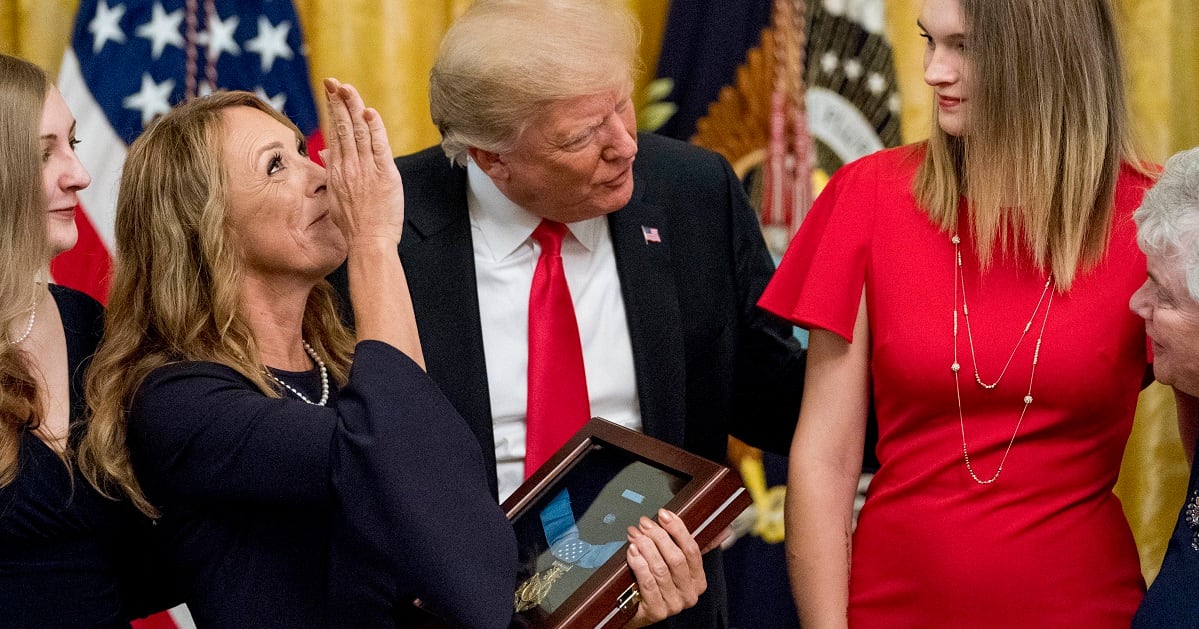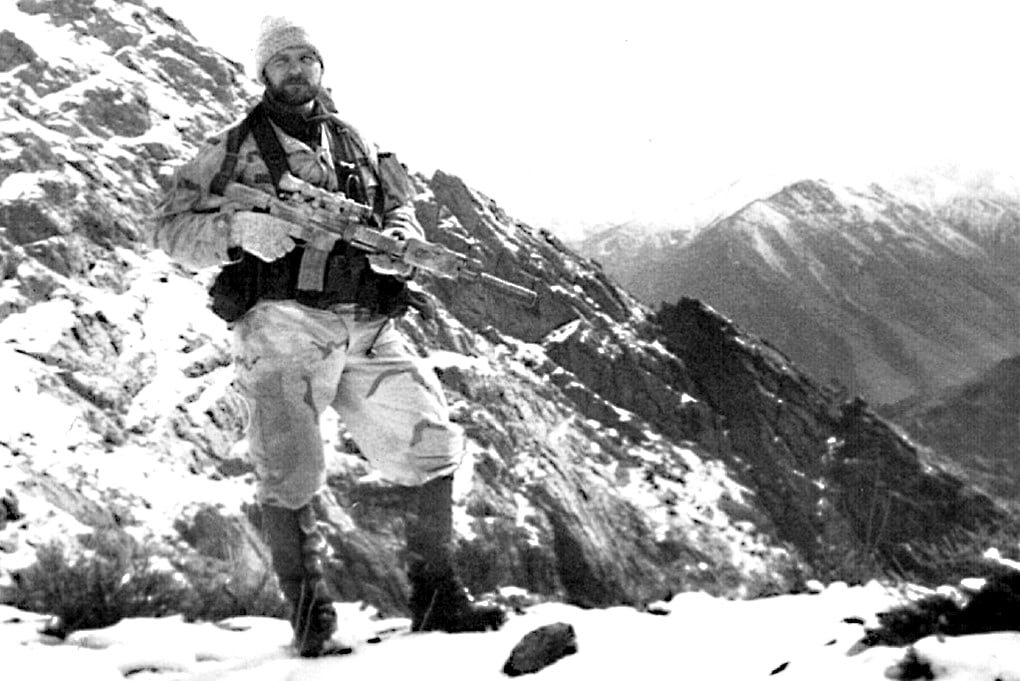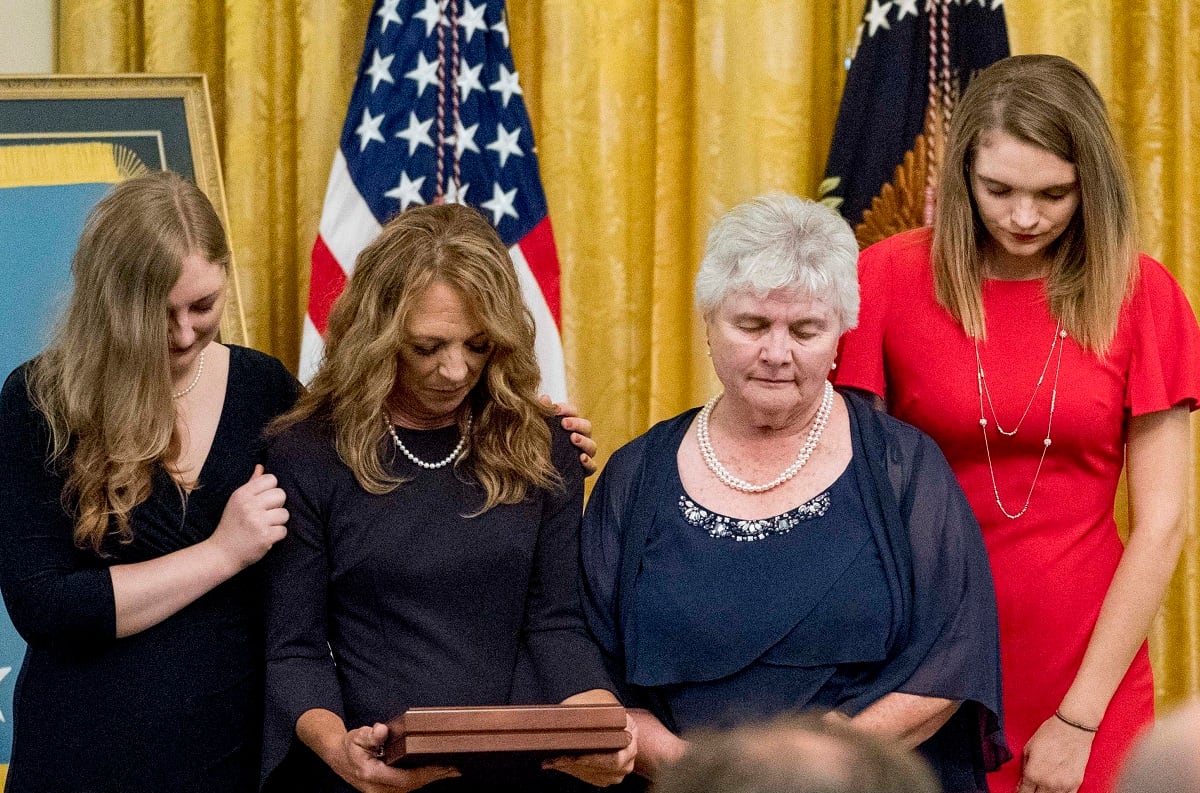Tech. Sgt. John Chapman, the combat controller who was killed trying to save the lives of a team of Army Rangers during a ferocious mountaintop battle in Afghanistan in 2002, was posthumously awarded the Medal of Honor Wednesday.
President Trump presented the nation’s highest award for valor to Chapman’s widow, Valerie Nessel, in a ceremony in the East Room of the White House. Chapman is now the first special tactics airman to receive the Medal of Honor, as well as the first airman to receive the nation’s highest award for valor for actions since the Vietnam War.
“We are gathered together this afternoon to pay tribute to a fallen warrior; a great warrior,” Trump said.
Trump described how, from an early age in Windsor Locks, Connecticut, Chapman was driven to “protect those in need.” Even as a young kindergartner, Trump said, he stood up to protect a friend who was being bullied.
“In his high school yearbook, John quoted these words: ‘Give yourself before taking of someone else,’” Trump said. “John lived by that motto every single day. Everybody who knew him said that’s the way he lived.”
After the 9/11 attacks, Trump said Chapman told his commander, “I need to go." A few months later, Chapman was part of a team of Navy SEALs taking part in Operation Anaconda, one of the most harrowing battles of the early days of the Afghanistan war. After their helicopter took heavy fire during the initial assault, Chapman and the other SEALs volunteered to return and try to rescue a teammate who had been thrown from the helicopter.
They found themselves in a ferocious firefight. Chapman was “the first to charge up the mountain toward the enemy,” Trump said, and left the safety of a bunker he had cleared to assault a second bunker containing al-Qaida fighters. Chapman was shot and lost consciousness, but despite his wounds, he woke up a few minutes later and resumed fighting for about an hour.
“And he really fought,” Trump said. “We have proof of that fight. He really fought. Good genes. He had good genes.”
Chapman saw another helicopter coming in, containing Army Rangers and airmen, and again emerged from his bunker to fight militants aiming rocket-propelled grenades at them. He was killed, but his actions are believed to have saved the lives of many of the troops on that helicopter.
“John gave his life for his fellow warriors,” Trump said. “Through his extraordinary sacrifice, John saved more than 20 American service members, some of whom are here today.”
The room erupted into raucous cheers as Trump presented the Medal of Honor to a beaming Nessel.

Trump also saluted as “brave people” the five previous Medal of Honor recipients in attendance at the ceremony, including retired Master Chief Special Warfare Operator Britt Slabinsky, the Navy SEAL who led Chapman’s team during the Battle of Takur Ghar.
In a panel discussion with reporters Tuesday, Nessel, Chapman’s mother Terry, his best friend and teammate Chief Master Sgt. Michael West and his squadron commander, Col. Ken Rodriguez, said they made it their mission to tell Chapman’s daughters, Brianna and Madison, what an “amazing man” he was.
“I tell them that he was such a genuine, good-hearted person,” Nessel said. “He lived his life — team before self — he lived his life that whole way. The girls and I meant everything to him. When he was home, he was home. He was 110 percent present as a father, as a husband. He was very humble, very kind, very soft-spoken. An amazing man who would be a little embarrassed having this bestowed upon him.”
West said he made sure Chapman’s daughters — Brianna was 3 and Madison was 5 when their father died — not only knew how much of a hero he was, but also heard about the good and funny times their father had.
“They relive his life through me sometimes,” West said. “They want to hear those stories. They like to hear from the guys, what he was like. To share those memories with them is priceless for me.”
RELATED

Chapman’s mother, Terry, said she wasn’t surprised at all that he sacrificed his life to save his fellow troops. From the time he was a small child, she said, Chapman was enormously empathetic and focused on helping other people.
“He was born with this ability to sense people’s feelings, or sense when people were in need of help. From when he was a toddler ... if I was upset, he’d come up [and say], ‘It’s OK, Mommy, it’s OK.’ And then as he got older, he would do all these different little acts of kindness that we didn’t find out; we heard all these stories after he was killed. I was totally blown away at how many lives he really affected for the good.”
Nessel and Chapman were married for 10 years, and met through a mutual friend.
“He was just full of life, loved people," Nessel said. "No matter what situation he was in or who he was with, he was able to interact with anybody. I’m sure all of you have seen the picture of him holding the Afghan baby — that was John. Those eyes touched his soul.”

Terry Chapman said her son attended one semester at the University of Connecticut after graduating from high school, but decided it wasn’t for him. He tried working in an auto body shop — and was very good at it — but still hadn’t found his path, she said.
“He said to his dad, ‘What do you think about me joining the Air Force?’" Terry Chapman said. “His dad said, ‘I think that’s a great idea.’ He said, ‘Well, that’s good, because I’ve already enlisted.’”
From the beginning, his mother said, he wanted to become a combat controller. She first talked him out of it because of how dangerous it was. But after four years of a desk job, Chapman knew he wouldn’t be happy doing anything but combat control and changed jobs.
“He always put others before himself,” Terry Chapman said. “He felt that was the right thing to do.”
Nessel said that about two or three years ago, when the military was reviewing several cases of valor to see if they merited higher awards, she found out that the technology had advanced to the point that a closer, frame-by-frame analysis of the video of an MQ-1 Predator flying above the battlefield was possible. That video allowed a closer analysis of Chapman’s actions at Takur Ghar, and was a key piece of evidence in the Air Force’s effort to upgrade his Air Force Cross to a Medal of Honor.
RELATED

Rodriguez said the video evidence verified what Chapman’s fellow airmen suspected all along: That he lived longer than originally believed, and continued fighting heroically to the end, saving the lives of Rangers whose helicopter was being targeted by rocket-propelled grenades.
“We were finally able to prove it,” Rodriguez said. “John survived that initial wounding that he got, and continued to fight on for an hour. And then at a crucial moment, right at the end of his life, he sacrificed his life for the incoming quick reaction force, when he could have hunkered down and said, ‘Finally, the guys are coming in to get me.’ But instead he said, ‘If I don’t do something, others are going to die.’ He’s clearly a Medal of Honor-worthy warrior.”
Nessel said she doesn’t feel her husband was left behind when his SEAL teammates — some of whom had been seriously wounded, and who believed Chapman had been killed early in the battle — withdrew under intense fire.
“Each of those men were doing what they were trained to do, at 10,000 feet, waist-deep snow,” Nessel said. “You can’t Monday morning quarterback anything. Each of those men are heroes. They were being shot at from each direction, and trying to protect the ones that were wounded. There’s not a question in my mind, that he was not left behind.”
“All the men in our special tactics community are cut from a different cloth,” Nessel said. “I believe if John were here, he would say every one of them would have done the same thing. That’s what they’re trained to do. It’s team before self. I don’t think for a second he thought about doing anything but protecting the other men on the helicopter coming in.”

Nessel praised all the troops who fought in the Battle of Roberts Ridge, and remembered the other men who also lost their lives: Special Warfare Operator 1st Class Neil Roberts, Senior Airman Jason Cunningham, Army Cpl. Matthew Commons, Army Sgt. Bradley Crose, Army Spc. Marc Anderson, and Army Sgt. Philip Svitak.
“I know if John were here, he would attest that all the men on the mountaintop that day were heroes,” Nessel said Tuesday. “It takes a true warrior to get off of a helicopter in a known enemy stronghold as it is being fired upon and charge the enemy. ... He would want this medal to not just be about him, it would be for all the men that were lost on that mountain.”
Nessel said that she and Chapman’s daughters are excited about the award — but it’s also a bittersweet and emotional experience for them, since they have few memories of their father.
“They know their daddy loved them, and they’re honored,” Nessel said. “In them, his legacy will continue. As long as they can tell his story to their children, and their children’s children, he will live forever.”
For her, Chapman’s Medal of Honor represents a “validation for what he had done on the mountain.”
She feels lucky that the technology is available to prove once and for all what happened on the Takur Ghar mountaintop. But the award doesn’t change how she has felt all along.
“It’s been a long road coming,” Nessel said. “But it doesn’t change anything as far as the pride. We’ve always been proud of him, and this doesn’t make us any more proud of him.”
Stephen Losey is the air warfare reporter for Defense News. He previously covered leadership and personnel issues at Air Force Times, and the Pentagon, special operations and air warfare at Military.com. He has traveled to the Middle East to cover U.S. Air Force operations.









